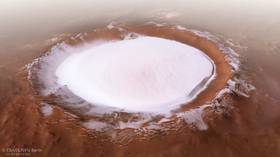Milky Way soiree: Our galaxy was filled with almost 100k supernovae roughly 1bn years ago

Approximately one billion years ago, the center of the Milky Way experienced a phenomenal period of starburst activity which produced the vast majority of stars in our galaxy, according to paradigm-shifting research.
Scientists now believe it was one of the most energetic periods in the Milky Way’s history, so rowdy in fact, that it may upend our current theories about star formation in our galactic backyard.
The galactic center is like the VIP section of the Milky Way night club, given that it’s so packed with stars, though admittedly most nightclubs don’t contain a supermassive black hole in the middle of the dance floor (it’s usually behind the bar).
Also on rt.com Cosmic threesome: Giant galaxy forms after trio of star systems SMASH into each otherThe region, which spans just 490-light-years across, has continued forming stars in the past few tens of millions of years but now, after an “unprecedented” survey of the galactic center (the GALACTICNUCLEUS survey), researchers have found that it’s nothing like the good ole days and star formation hasn’t remained constant throughout the Milky Way’s history. Far from it, in fact.
Instead, researchers using the European Southern Observatory’s Very Large Telescope (VLT) found that roughly 90 percent of the stars in the galactic center were formed during the first half of the galaxy’s life, between eight and 13.4 billion years ago, back when MTV still played music.

“Contrary to what had been accepted up to now, we found that the formation of stars has not been continuous,” said astronomer Francisco Nogueras-Lara of the Max Planck Institute for Astronomy in Germany.
But all good things must come to an end, and after the initial flurry of activity it now seems as though there were roughly six billion years of, well, not much happening – a galactic hangover, if you will.
But then, like Lazarus himself, the galaxy finally sprung back to life about one billion years ago, furiously churning out stars like the glory days of yore – with a combined mass of up to 42 million times that of our sun.
Also on rt.com Runaway Star ejected from Milky Way’s ‘Heart Of Darkness’ at 6 MILLION kmph (VIDEO)“The conditions in the studied region during this burst of activity must have resembled those in starburst galaxies, which form stars at rates of more than 100 solar masses per year,” said Nogueras-Lara, who conducted the research at the Institute of Astrophysics of Andalusia in Spain.
The researchers now estimate that the initial period was dominated by one kind of star: extremely massive suns that burned very hot and very bright but only lasted about 10 million years each before going out in a supernova blaze of glory. Lightweights, in galactic terms.
“This burst of activity, which must have resulted in the explosion of more than a hundred thousand supernovae, was probably one of the most energetic events in the whole history of the Milky Way,” Nogueras-Lara said.
Like this story? Share it with a friend!














